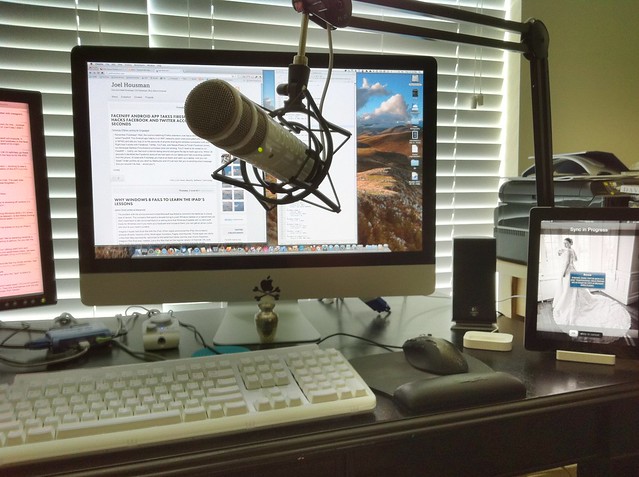Finding A Replacement For Reeder
By grouping iOS apps into niche markets, aside from the static categories that Apple defines in the App Store, at the top of any list has to include RSS, To-Do, and Twitter clients. There are many options for these three types of apps to choose from, and everyone has their favorites. To-Do apps in particular seem to be all over the map with no clear favorite (except maybe Clear? Pun intended). However, with Twitter or RSS reading apps - Tweetbot and Reeder seem to be the clear frontrunners.

Recently Reeder pushed out a major update for the iPhone version of its iOS application. Many things have changed about it, the biggest changes being the user interface, and supported services. I didn't like either of these changes, as well as how Reeder seems to be promoting Readability over other offline reading services such as Instapaper or Pocket. My offline reading application of choice is Instapaper, and I dislike Pocket…but I very much dislike Readability due to their ongoing lack of respect for their cusomters and publishers.

Because of these reasons, and a few other minor subjective annoyances I have with the user interface of Reeder, I've been searching for a worthy replacement as my main iOS RSS client for about a year now. Without naming names, I've tried many of Reeder's competitors and not found any that I like sufficiently enough to use instead of Reeder. The last time I searched possible replacements about 6 months ago, I came up short. The other day, however, Reeder pushed out a new update for the iPhone version of their app. This new update shoves the Readability icon onto the top of the UI of every individual post. Even after going into settings and turning off Readability, the icon is still present which links to the mobilizer version of Readability. As I detest Readability, the company, and everything it stands for, this simply will not do. Thus began my search for a replacement once again.
As I was writing this review, Reeder has pushed out an update that allows the end user to remove ther Readability mobilizer from view. Regardless of this, the direction the developer is taking this app has lead me to seek out alternatives.
After a few searches,
I came across Newsify. At first, the preview screenshots within the store did not get my attention, but after browsing a few other apps and then ranking them by high-ranking reviews, I came back to Newsify. Due to its price of $0.99, I threw caution to the wind and bought it.
Visual Design
So far, I couldn't be happier. I'll start with the icon, which you can see a little higher up in this article. I like the design and it looks nice on my homescreen (and for my iPad, on my dock). The icon design is clean and is easy to pick out from the rest of my home screen apps. Also, it is not blue…don't get me wrong, I love blue, but so many apps tend to go with that color.
The entire UI of the application uses custom artwork and while some of the icons are similar to the default UIKit artwork, the developer has done a good job of using the same elements users are familiar with, such as the refresh circle, while making custom icons for the 'mark as read' menu or the sharing menu.
Within a folder or 'all feeds' sub-menu, the application displays articles in a nice reader-friendly view giving beautifully formatted excerpts of each feed item with a thumbnail image if the article has one. See the below screenshot for an example.

Newsify showing the MacRumors feed view.
Animations
One of the features I liked about Reeder was the ability to pull-down on articles to move on to the next item. Mimicing Loren Brichter's pull-to-refresh idea, Reeder allowed a user o pull-down or pull-up on an article which would scroll down or back up to other feed items. Other Reeder competitors (Newsrack comes to mind) did not allow for this scroll motion, and instead, cramped up and down arrows into the top right corner of the user interface. In effect, this made reading items quite tedious when holding my iPad in portrait mode. I tend to hold my iPad from the bottom, especially when laying on the couch or in bed. Arrow controls in the top right corner caused me to have to constantly move a hand off the iPad to interact with those UI controls, while trying to continue holding the iPad with my other hand. This isn't horrible when reading longer articles but when skimming down a feeds list, it was very tedious. Newsify uses the same pull/push to progress gesture as Reeder, however, the animation that Newsify uses is very satisfying to use. It reminds me a lot of the original pull-to-refresh from Tweetie in its use. There is a suble arrow flip, from down to up or up to down as you pull or push, and beside this arrow, Newsify gives you a preview of the headline of the next or previous feed. It is very nicely done.
Settings
A point that may sometimes make or break an app (if there is a lack-thereof) are the settings. I am happy to report that Newsify offers a ton of custom settings for reading, fonts, sorting, refreshing, visual elements, home-screen options, and the ability to customize your sharing service options. Given that I want to eliminate seeing services I do not use, such as Readability, I greatly appreciate this.
Another feature I appreciate is the ability to add, remove, and manage my feeds from within the application. Other competitors do not offer this feature, but instead force the user to log into reader.google.com to manage your subscriptions. Forcing me to log into a Google product never makes me happy.
The Developer
I reached out to the developer, Ben Alexander, to ask him a few questions about his application. Ben made Newsify by himself, doing all development and design. He launched the application on April 22, 2012, and says that it has been very successful so far. Apple even recently featured it in the App Store. When I asked Ben why he decided to develop and release an RRS client in an already crowded market for this particular niche, he said:
"As a Google Reader user, I was looking for a more visually interesting way to read RSS feeds. I couldn't find anything that was satisfying to me and thought others might feel the same way."
Ben was also kind enough to talk about some upcoming features for Newsify:
The next update will bring night mode, mark read while scrolling, tap and hold to mark read and a few other improvements.
As for the previous releases on Newsify, there have been several updates to the app since release. Ben is doing an excellent job staying on top of things as far as updates. It is also one of the top RSS reader clients on the App Store based on positive ratings. I feel fairly confident Ben will continue to activley develop this app for some time which makes me at ease with choosing this as my RSS reader.∗

This morning, Apple released OS X Mountain Lion (10.8) on the Mac App Store, for $19.95. I have been using Mountain Lion since Beta 3 as a part of the OS X Developer Program. While there were a few bugs during the betas, as to be expected, the ones I noticed were all fixed by Apple by the time they released the GM Seed to developers a few weeks ago. Since then, the OS has been rock solid. There are lots of new features, many of which I think you'll appreciate. Rather than attempt to explain them to you myself, I wanted to list a few places where you can go read reviews of Mountain Lion written by the veteran reviewers themselves.
First and foremost, I want to point out, that John Siracusa has once again written one of his famous OS X reviews (Web or Kindle) . John's review, which weighs in at 25,935 words, is the most in-depth review of all reviews. John has famously written epicly detailed reviews of OS X going on for over a decade now. His reviews are a must-read by die hard Apple users, so much so that Marco Arment has wrote a review of his review (which is quite funny to read).






